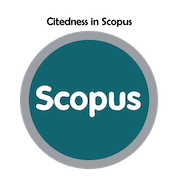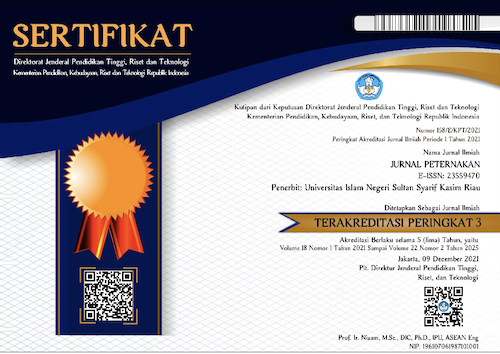The Impact of The Environmental Temperature-Humidity Index on Ammonia Concentration (NH3) in Laying Hen Farming
Abstract
Keywords
Full Text:
PDFReferences
Adler, Carolin, Alexander J. Schmithausen, Manfred Trimborn, Sophia Heitmann, Birgit Spindler, Inga Tiemann, Nicole Kemper, and Wolfgang Büscher. 2021. “Effects of a Partially Perforated Flooring System on Ammonia Emissions in Broiler Housing—Conflict of Objectives between Animal Welfare and Environment?” Animals 11(3):1–15. doi: 10.3390/ani11030707.
Ahmadi Babadi, Keyvan, Hossein Khorasanizadeh, and Alireza Aghaei. 2022. “CFD Modeling of Air Flow, Humidity, CO2 and NH3 Distributions in a Caged Laying Hen House with Tunnel Ventilation System.” Computers and Electronics in Agriculture 193:106677. doi: 10.1016/J.COMPAG.2021.106677.
Andrade, Rafaella Resende, Fernando Costa Baêta, and Matteo Barbari. 2017. “Evaluation of the Surface Temperature of Laying Hens in Different Thermal Environments during the Initial Stage of Age Based on Thermographic Images.” Agronomy Research 15(3):629–38.
Apalowo, Oluwabunmi O., Deji A. Ekunseitan, and Yewande O. Fasina. 2024. “Impact of Heat Stress on Broiler Chicken Production.” Poultry 3(2):107–28. doi: 10.3390/poultry3020010.
Arianto, Putri, Abdul Rohim Tualeka, Desheila Andarini, Pudji Rahmawati, Syamsiar S. Russeng, and Atjo Wahyu. 2019. Determination of Ammonia Gas Safe Concentration in Chicken Farm Workers in Lembak Village, South Sumatra Indonesia. Vol. 10.
Chen, Baitong, Jacek A. Koziel, Chumki Banik, Hantian Ma, Myeongseong Lee, Jisoo Wi, Zhanibek Meiirkhanuly, Samuel C. O’Brien, Peiyang Li, Daniel S. Andersen, Andrzej Białowiec, and David B. Parker. 2020. “Mitigation of Odor, NH3, H2S, GHG, and VOC Emissions With Current Products for Use in Deep-Pit Swine Manure Storage Structures.” Frontiers in Environmental Science 8. doi: 10.3389/fenvs.2020.613646.
Diaz, Ángel Rosario, § Rafael Alavez Ramirez, Magdaleno Caballero Caballero, Fernando Chiñas Castillo, José Luis Montes Bernabé, María Eugenia, and Silva Rivera. 2018. “Analysis of Hygrothermal Conditions for Laying Hens in the State of Oaxaca.” Revista Mexicana de Ciencias Agrícolas Special Volume(21):4317–27.
Dinas Peternakan dan Perikanan Kabupaten Sidrap. 2022. “Populasi Unggas Menurut Kecamatan Dan Jenis Unggas Di Kabupaten Sidenreng Rappang Tahun 2021.” Pemerintah Daerah Kabupaten Sidenreng Rappang. Retrieved June 11, 2024 (https://sidrapkab.go.id/site/index.php?/Potensi/detail_potensi/8).
Direktorat Jenderal Peternakan dan Kesehatan Hewan Kementerian Pertanian. 2022. “Statistik Peternakan Dan Kesehatan Hewan 2022/ Livestock and Animal Health Statistics 2022.” Issn 2964-1047 1:1–276.
EDGAR. 2015. “Edgar - Emissions Database for Global Atmospheric Research. Global Air Pollutant Emissions - EDGAR v5.0. .” EDGAR - Emissions Database for Global Atmospheric Research. Retrieved May 22, 2023 (https://edgar.jrc.ec.europa.eu/gallery?release=v50_AP&substance=NH3§or=TOTALS).
Eglin, Thomas, and Melynda Hassouna. 2016. Measuring Emissions from Livestock Farming-Greenhouse Gases, Ammonia and Nitrogen Oxides. RMT-Elevages and Environnement.
Fabbri, C., L. Valli, M. Guarino, A. Costa, and V. Mazzotta. 2007. “Ammonia, Methane, Nitrous Oxide and Particulate Matter Emissions from Two Different Buildings for Laying Hens.” Biosystems Engineering 97(4):441–55. doi: 10.1016/J.BIOSYSTEMSENG.2007.03.036.
Gržinić, Goran, Agnieszka Piotrowicz-Cieślak, Agnieszka Klimkowicz-Pawlas, Rafał L. Górny, Anna Ławniczek-Wałczyk, Lidia Piechowicz, Ewa Olkowska, Marta Potrykus, Maciej Tankiewicz, Magdalena Krupka, Grzegorz Siebielec, and Lidia Wolska. 2023. “Intensive Poultry Farming: A Review of the Impact on the Environment and Human Health.” Science of the Total Environment 858(November 2022). doi: 10.1016/j.scitotenv.2022.160014.
Intergovernmental Panel on Climate Change. 2019. “Volume 4: Agriculture, Forestry and Other Land Use. Chapter 10: Emissions Form Livestock and Manure Management.” 2019 Refinement to the 2006 IPCC Guidelines for National Greenhouse Gas InventorieS 4:209.
Kang, Seokmin, Da Hye Kim, Sang Lee, Taehoon Lee, Kyung Woo Lee, Hong Hee Chang, Byunghern Moon, Tugay Ayasan, and Yang Ho Choi. 2020. “An Acute, Rather Than Progressive, Increase in Temperature-Humidity Index Has Severe Effects on Mortality in Laying Hens.” Frontiers in Veterinary Science 7. doi: 10.3389/fvets.2020.568093.
Kilic, Ilker, and Erkan Yaslioglu. 2014. “Ammonia and Carbon Dioxide Concentrations in a Layer House.” Asian Australas. J. Anim. Sci. 27(8):1211–18.
Kim, Eunhye, Byeong Uk Kim, Hyun Cheol Kim, and Soontae Kim. 2021. “Sensitivity of Fine Particulate Matter Concentrations in South Korea to Regional Ammonia Emissions in Northeast Asia.” Environmental Pollution 273. doi: 10.1016/j.envpol.2021.116428.
Ksheem, Abdalhakim M., and Diogenes L. Antille. 2016. “Nutrient Composition and Nutrient Losses during Composting of Chicken Manures as Affected by Addition of Sawdust.” CYPRUS 2016 4 Th International Conference on Sustainable Solid Waste Management 1–5.
Kumar, Faneshwar, Lipismita Samal, and Kalyan Behera. 2016. Use of Temperature-Humidity Index in Energy Modeling for Broiler Breeder Pullets in Hot and Humid Climatic Conditions Kamdev Sethy.
Li, Dapeng, Qin Tong, Zhengxiang Shi, Weichao Zheng, Yu Wang, Baoming Li, and Geqi Yan. 2020. “Effects of Cold Stress and Ammonia Concentration on Productive Performance and Egg Quality Traits of Laying Hens.” Animals 10(12):1–14. doi: 10.3390/ani10122252.
Lohmann Management Guide. 2020. Lohmann Brown-Classic Layers. Vol. Lohmann Breeder. Germany: Lohmann Breeders.
Mohammed, Asmaa N. 2022. “How Can Ammonia’s Hygienic Problems in Poultry Houses Be Alleviated? Review Article.” Egyptian Journal of Veterinary Science(Egypt) 53(2):285–92. doi: 10.21608/ejvs.2022.103968.1310.
Mwesigwa, M., J. Semakula, P. Lusembo, J. Ssenyonjo, R. Isabirye, R. Lumu, and T. Namirimu. 2016. “Effect of Pre-Incubation and Incubation Conditions on Hatchability and Chick Quality of Kuroiler Chickens.” Uganda Journal of Agricultural Sciences 16(1):115. doi: 10.4314/ujas.v16i1.10.
Naseem, Sadia, and Annie J. King. 2018. “Ammonia Production in Poultry Houses Can Affect Health of Humans, Birds, and the Environment—Techniques for Its Reduction during Poultry Production.” Environmental Science and Pollution Research 25(16):15269–93. doi: 10.1007/s11356-018-2018-y.
Nieuwolt, Snippet. 1977. Tropical Climatology: An Introduction to the Climates of the Low Latitudes. London: London New York Wiley.
Orzi, V., C. Riva, B. Scaglia, G. D’Imporzano, F. Tambone, and F. Adani. 2018. “Anaerobic Digestion Coupled with Digestate Injection Reduced Odour Emissions from Soil during Manure Distribution.” Science of the Total Environment 621:168–76. doi: 10.1016/j.scitotenv.2017.11.249.
Rajab, Ridwan, Firman Hadi Rivai, and Bambang Suhartono. 2022. “The Economic Prospects of Chicken Slaughterhouse Industry in Residential Environments.” The 3rd International Conference of Governance, Public Administration, and Social Science (ICoGPASS) 2022:1331–47.
Sheikh, I. U., S. S. Nissa, B. Zaffer, K. H. Bulbul, A. H. Akand, Ahmed H.A., D. Hasin, I. Hussain, and S. A. Hussain. 2018. “Ammonia Production in the Poultry Houses and Its Harmful Effects.” International Journal of Veterinary Sciences and Animal Husbandry 3(4):30–33.
Sitorus, Winda Virdya, Dwi Sunarti, and Adi Sarjana. 2019. “Comparison of Broiler Chicken Behavioral Response in Differing Closed House Length throughout the Dry Season.” Jurnal Peternakan Integratif 7(2):19–24.
Sugiyono. 2013. Metode Penelitian Kuantitatif Kualitatif Dan R & D. 13th ed. Bandung: CV Alfabeta.
Swelum, Ayman A., Mohamed T. El-Saadony, Mohamed E. Abd El-Hack, Mahmoud M. Abo Ghanima, Mustafa Shukry, Rashed A. Alhotan, Elsayed O. S. Hussein, Gamaleldin M. Suliman, Hani Ba-Awadh, Aiman A. Ammari, Ayman E. Taha, and Khaled A. El-Tarabily. 2021. “Ammonia Emissions in Poultry Houses and Microbial Nitrification as a Promising Reduction Strategy.” Science of the Total Environment 781:1–17. doi: 10.1016/j.scitotenv.2021.146978.
Ulupi, Niken, and Rudi Afnan. 2016. “Level of Ammonia, Dust, Production Performance, and Egg Quality of Laying Hens on Cage and Litter System in Tropical Area.” International Journal of Sciences: Basic and Applied Research (IJSBAR) International Journal of Sciences: Basic and Applied Research 30(5):339–48.
Wei, F. X., X. F. Hu, B. Xu, M. H. Zhang, S. Y. Li, Q. Y. Sun, and P. Lin. 2015. “Ammonia Concentration and Relative Humidity in Poultry Houses Affect the Immune Response of Broilers.” Genetics and Molecular Research 14(2):3160–69. doi: 10.4238/2015.April.10.27.
Zaky, Fadhil Achmad, Ardia Candra Fajar Herbowo, Faisya Haqqin Abrari, Haydar Ally, Muhammad Adib Al-Dzahabi, Muhammad Hanif Ahsani Taqwim, Naila Maulida Ibriza, Nida Ulhaq Fil, Yonanda Surya Agustin, and Agnar Pradipa Daniswara. 2024. “Kajian Kualitas Udara Analisis Temperature Humidity Index (THI) Secara Time-Series Menggunakan Sistem Monitoring Berbasis Internet of Things (IoT) Di Kelurahan Sumber, Banjarsari, Surakarta.” Jurnal Ekosains 16(1):44–51.
Zhang, Yu, Zhiping Zhu, Yunhao Zheng, Yongxing Chen, Fubin Yin, Wanqin Zhang, Hongmin Dong, and Hongwei Xin. 2019. “Characterization of Volatile Organic Compound (VOC) Emissions from Swine Manure Biogas Digestate Storage.” Atmosphere 10(7). doi: 10.3390/atmos10070411.
Zhao, Zhonghao, Xiuguo Zou, Zhengling Yin, Zhibin Cao, Jie Zhang, Chenyang Wang, Wenchao Liu, and Yungang Bai. 2021. “Research on the Correlation between Breeding Environment and Activity of Yellow Feather Broilers Based on the Multichromatic Aberration Model.” Computational Intelligence and Neuroscience 2021. doi: 10.1155/2021/2897879.
Zhou, Ying, Minhong Zhang, Qingxiu Liu, and Jinghai Feng. 2021. “The Alterations of Tracheal Microbiota and Inflammation Caused by Different Levels of Ammonia Exposure in Broiler Chickens.” Poultry Science 100(2):685–96. doi: 10.1016/j.psj.2020.11.026.
DOI: http://dx.doi.org/10.24014/jupet.v22i2.30768
Refbacks
- There are currently no refbacks.
Jurnal Peternakan has been accredited by Sinta 3 : Number 158/E/KPT/2021
Starting from Vol. 18 No. 1 Year 2021 to Vol. 22 No. 2 Year 2025
Jurnal Peternakan Indexed By:
Editorial Office:
Jurnal Peternakan
Faculty of Agriculture and Animal Science, State Islamic University of Sultan Syarif Kasim Riau.
H.R. Soebrantas street KM. 15,5 Panam – Pekanbaru city.
E-mail: jurnal.peternakan@uin-suska.ac.id
ejournal: http://ejournal.uin-suska.ac.id/index.php/peternakan

Creation is distributed under the Creative Commons Attribution 4.0 International License. View Mystats















